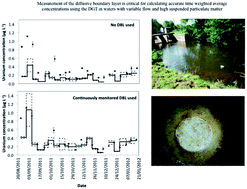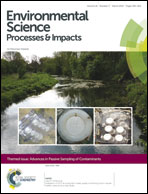Evaluation of DGT as a long-term water quality monitoring tool in natural waters; uranium as a case study†
Abstract
The performance of the diffusive gradient in thin film technique (DGT) was evaluated as a tool for the long-term monitoring of water quality, using uranium as a case study. DGTs with a Metsorb™ (TiO2) sorbent were deployed consecutively at two alkaline freshwater sites, the River Enborne and the River Lambourn, UK for seven-day intervals over a five-month deployment period to obtain time weighted average concentrations. Weekly spot samples were taken to determine physical and chemical properties of the river water. Uranium was measured in these spot samples and after extraction from the DGT devices. The accuracy of the DGT device time weighted average concentrations to averaged spot water samples in both rivers was 86% (27 to 205%). The DGT diffusive boundary layer (DBL) (0.037–0.141 cm – River Enborne and 0.062–0.086 cm – River Lambourn) was affected by both water flow and biofouling of the diffusion surface. DBL thicknesses found at both sites were correlated with flow conditions with an R2 value of 0.614. Correlations were also observed between the DBL thickness and dissolved organic carbon (R2 = 0.637) in the River Lambourn, indicating the potential presence of a complex zone of chemical interactions at the surface of the DGT. The range of DBL thicknesses found at the River Lambourn site were also attributed to of the development of macro-flora on the active sampling surface, indicating that the DBL thickness cannot be assumed to be water flow dependant only. Up to a 57% under-estimate of uranium DGT concentration was observed compared to spot sample concentrations if the DBL was neglected. This study has shown that the use of DGT can provide valuable information in environmental monitoring schemes as part of a ‘tool-box’ approach when used alongside conventional spot sampling methods.

- This article is part of the themed collection: Advances in Passive Sampling of Contaminants

 Please wait while we load your content...
Please wait while we load your content...